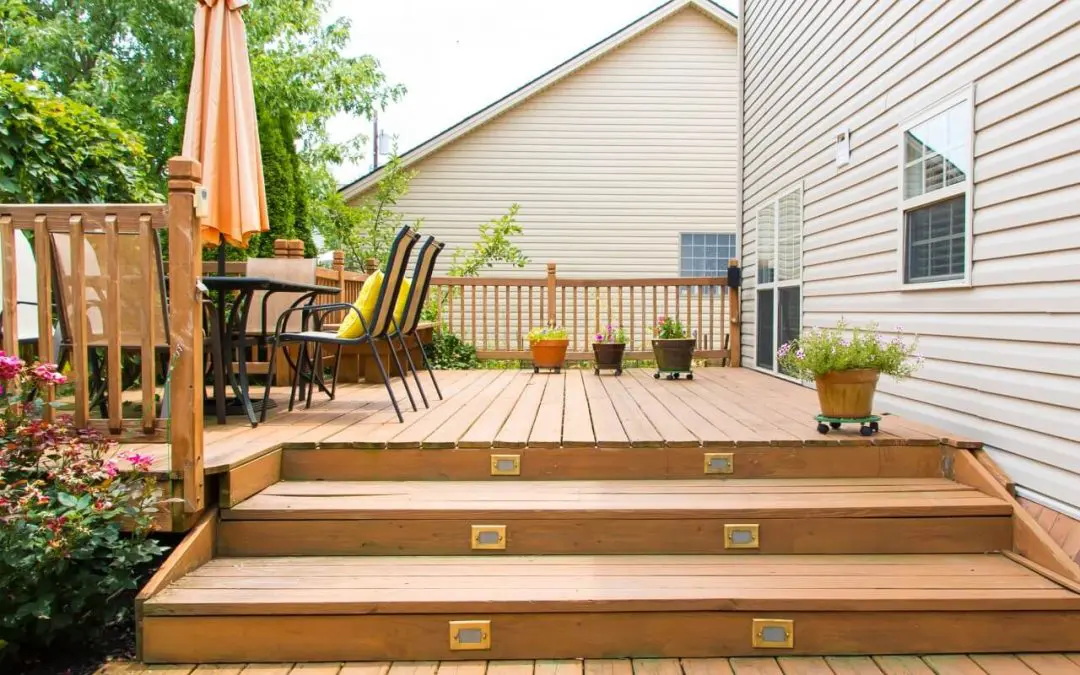A deck increases your home’s living space while adding value to the property. When adding a deck, one of the main decisions to make is the material you will use. Here are five types of decking materials, along with their pros and cons.
How to Choose Types of Decking Materials
When shopping for decking materials, figure out your budget. Decide beforehand on an amount of money to spend on the project. To plan your budget, discuss factors like the size of the deck, features you’d like to add, labor costs, the building permit fee, and the price of materials.
To choose the best material, you’ll also want to think about how much maintenance you are willing to do. Different decking materials have different requirements for upkeep. You might save money on the lumber, but spend a lot of time cleaning, sanding, and re-sealing the finished deck.
Pressure-Treated Lumber
If you’re looking for affordability, pressure-treated wood is the choice for you. It’s usually made from pine, though other options are available. After it’s cut to length, the manufacturer treats the wood with chemicals, making it more durable for outdoor use.
Besides being affordable, pressure-treated wood is easy to install. Cutting the wood requires a common hand or electric saw. It can easily be secured to the frame using screws or nails.
On the downside, this type of decking material requires more maintenance. It needs to be pressure washed to keep it clean. You will need to paint or seal it every few years. Over time, the wood will start to crack, warp, and splinter.
Redwood or Cedar
Cedar and redwood contain natural oils and tannins which help them resist rot, without the use of chemicals. That fact and their natural beauty are reasons they’ve been a popular decking choice for decades. These woods are graded by quality. The highest quality comes from the heart of the tree.
One of the biggest draws to redwood and cedar are their grain patterns. They are attractive in almost any setting. Another advantage of these woods is their durability. Redwood and cedar will last longer than pressure-treated wood if they are properly maintained.
Maintenance is the downside to these woods. They lose their color over time. To keep them looking good, the wood needs a fresh coat of sealer every few years. Plus, it needs pressure washed at least once a year.
Tropical Hardwood are Durable Types of Decking Materials
Tropical hardwoods like teak, ipe, and rosewood offer a unique look, along with strength and durability. These woods can last up to fifty years. Sustainable harvesting of these options can minimize environmental impact.
As a type of decking material, tropical hardwoods are the most expensive option. Due to their hardness, they are also difficult to cut and install. They don’t take stains or sealants well.
Aluminum
If you want a unique, modern look, aluminum decking is a good choice. It requires little maintenance compared to other decking materials. Aluminum won’t crack, splinter, or rust. It won’t peel or fade and it resists mold and mildew.
Noise is a problem with aluminum. When someone walks across an aluminum deck, it can be loud. When it rains or snows, aluminum is slippery. It also costs more than other decking materials.
Types of Decking Materials Include Composites
If you are looking for a type of decking material that’s durable, but not as costly as tropical hardwoods, composite decking is an option. It can be made from a mixture of wood and plastic or completely from plastic.
Composites are easy to maintain and won’t splinter like pressure-treated wood. Those made with wood scraps can decay over time. They tend to collect water and can harbor mold and mildew if not cleaned periodically.
Each type of decking material has pros and cons. When selecting one, consider your budget, the style you want, and the value it will add to your home.
Jones & Cooper Home Inspections provides inspections to homes in Metro Louisville. Contact us to schedule an appointment.

